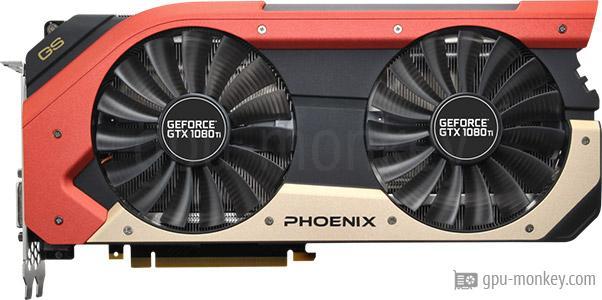
Gainward GeForce GTX 1080 Ti Phoenix GS
Benchmark and Specs
Last updated:
Benchmark and Specs
Here you will find all technical data as well as various benchmarks of the Gainward GeForce GTX 1080 Ti Phoenix GS. Up to 4 screens with a maximum resolution of up to 7680x4320 can be operated with this graphics card. The maximum turbo clock of the Gainward GeForce GTX 1080 Ti Phoenix GS is 1.670 GHz, so the graphics card achieves an FP32 computing power of 11.97 TFLOPS.
GPUThe Gainward GeForce GTX 1080 Ti Phoenix GS is equipped with 28 execution and 3584 shader units. With single precision, a theoretical FP32 computing power of 11.97 TFLOPS is achieved. |
|
| Based on: | NVIDIA GeForce GTX 1080 Ti |
| GPU Chip: | GP102-350-K1-A1 (Pascal) |
| Streaming Multiprocessors: | 28 |
| Shader: | 3584 |
| Render Output Units: | 88 |
| Texture Units: | 224 |
| Raytracing Cores: | 0 |
MemoryThe Gainward GeForce GTX 1080 Ti Phoenix GS has a 352 bit wide memory interface, with which a memory bandwidth of 484 GB/s is achieved. In total, 11 GB GDDR5X graphics memory is available for the graphics card. |
|
| Memory Size: | 11 GB |
| Memory Type: | GDDR5X |
| Memory Clock: | 1.376 GHz |
| Memory Speed: | 11.0 Gbps |
| Memory bandwidth: | 484 GB/s |
| Memory Interface: | 352 bit |
Clock SpeedsThe manufacturer specifies the memory clock of the Gainward GeForce GTX 1080 Ti Phoenix GS with 1.556 GHz (base clock) or with 1.670 GHz (turbo clock). If overclocking is supported (see below), the clock rate can be increased even further. |
|
| Base Clock: | 1.556 GHz + 5 % + 5 % |
| Boost Clock: | 1.670 GHz + 6 % + 6 % |
| Avg (Game) Clock: | |
| Overclocking: | Yes |
Thermal DesignThe Gainward GeForce GTX 1080 Ti Phoenix GS has 2 x 8-Pin plugs, which supply the graphics card with energy. The maximum operating temperature of the card is 91 °C. |
|
| TDP: | 250 W |
| TDP (up): | -- |
| Tjunction max: | 91 °C |
| PCIe-Power: | 2 x 8-Pin |
Cooler & FansThe Gainward GeForce GTX 1080 Ti Phoenix GS is equipped with 2 Axial main fans, which are used to cool the graphics processor and graphics memory. |
|
| Fan-Type: | Axial |
| Fan 1: | 2 x 100 mm |
| Fan 2: | -- |
| Cooler-Type: | Air cooling |
| Noise (Idle): | 0 dB / Silent |
| Noise (Load): | -- |
ConnectivityUp to 4 screens can be connected to the Gainward GeForce GTX 1080 Ti Phoenix GS, whereby the backward-compatible HDCP copy protection is supported in the 2.2 version. |
|
| Max. Displays: | 4 |
| HDCP-Version: | 2.2 |
| HDMI Ports: | 1x HDMI v2.0b |
| DP Ports: | 3x DP v1.4 |
| DVI Ports: | 1 |
| VGA Ports: | -- |
| USB-C Ports: | -- |
FeaturesetThe Gainward GeForce GTX 1080 Ti Phoenix GS supports a maximum resolution of 7680x4320 pixels and the DirectX standard version 12_1. |
|
| Max. resolution: | 7680x4320 |
| DirectX: | 12_1 |
| Raytracing: | No |
| DLSS / FSR: | Yes |
| LED: | No LED lighting |
Supported Video CodecsHere is a list of which video codecs can be decoded / encoded by the Gainward GeForce GTX 1080 Ti Phoenix GS in hardware in order to minimize the processor load. |
|
| h264: | Decode / Encode |
| h265 / HEVC: | Decode / Encode |
| VP8: | Decode |
| VP9: | Decode |
| AV1: | No |
DimensionsThe dimensions of the Gainward GeForce GTX 1080 Ti Phoenix GS are 285 mm in length, 133 mm in height and -- in width. Thus 3 PCIe-Slots are needed in a case. |
|
| Length: | 285 mm |
| Height: | 133 mm |
| Width: | -- |
| Width (Slots): | 3 PCIe-Slots |
| Weight: | -- |
Additional dataThe Gainward GeForce GTX 1080 Ti Phoenix GS is manufactured in a structure width of 16 nm and has a PCIe 3.0 x 16 lanes interface. The graphics card was released in Q1/2017. |
|
| GPU Interface: | PCIe 3.0 x 16 |
| Release date: | Q1/2017 |
| Launch Price: | 699 $ (Reference) |
| Structure size: | 16 nm |
| Part-no: | 426018336-3934 |
| Documents: | data sheet |
Rate this graphics card
Benchmark results
3DMark Benchmark (DirectX, Raytracing)
3DMark is a benchmark program that determines the performance of certain components of a computer and then reports the performance as a numerical value.
Time Spy Extreme Graphics score

|
Gainward GeForce GTX 1080 Ti Phoenix GS
11 GB GDDR5X |
||

|
NVIDIA GeForce GTX 1080 Ti
Average of gpu group |
||
Battlefield 5
Battlefield 5 is a visually stunning game that is ideal as a graphics card benchmark. We test the game with maximum details on Windows 10.
3840x2160 (2160p)

|
Gainward GeForce GTX 1080 Ti Phoenix GS
11 GB GDDR5X |
||

|
NVIDIA GeForce GTX 1080 Ti
Average of gpu group |
||
2560x1440 (1440p)

|
Gainward GeForce GTX 1080 Ti Phoenix GS
11 GB GDDR5X |
||

|
NVIDIA GeForce GTX 1080 Ti
Average of gpu group |
||
1920x1080 (1080p)

|
Gainward GeForce GTX 1080 Ti Phoenix GS
11 GB GDDR5X |
||

|
NVIDIA GeForce GTX 1080 Ti
Average of gpu group |
||
Geekbench 6 (OpenCL, Vulkan, Metal)
Geekbench 6 is a cross-platform benchmark for main processors, which also carries out 3 different graphics benchmarks and outputs them in the form of a numerical value.
Geekbench 6 - OpenCL

|
Gainward GeForce GTX 1080 Ti Phoenix GS
11 GB GDDR5X |
||

|
NVIDIA GeForce GTX 1080 Ti
Average of gpu group |
||
Geekbench 6 - Vulkan

|
Gainward GeForce GTX 1080 Ti Phoenix GS
11 GB GDDR5X |
||

|
NVIDIA GeForce GTX 1080 Ti
Average of gpu group |
||
FP32 Performance (Single-precision TFLOPS)
The theoretical computing power of the graphics card with single precision (32 bit) in TFLOPS indicates how many trillion FP32 floating point operations the graphics card (GPU) can perform per second.
FP32 (TFLOPS)

|
Gainward GeForce GTX 1080 Ti Phoenix GS
11 GB GDDR5X |
||
More benchmarks
In order to determine the performance of a graphics card, so-called "benchmarks" are carried out. The benchmark software carries out special calculations to determine the performance of a graphics card. We use so-called theoretical or synthetic benchmarks (e.g. 3D Mark) as well as real game benchmarks. To ensure real comparability of the results, we pay attention to the correct execution of the benchmarks as well as the condition of the graphics card and the system.We use the following benchmarks to measure the performance of a graphics card:

3DMark Benchmark
5,159 entries
5,159 entries

GTA 5 Benchmark
4,624 entries
4,624 entries

Shadow of the Tomb Raider
5,148 entries
5,148 entries

Battlefield 5
4,510 entries
4,510 entries

Geekbench 6
5,151 entries
5,151 entries

Crypto-Mining Ethereum Hashrate
3,506 entries
3,506 entries

Crypto-Mining Ergo Hashrate
3,737 entries
3,737 entries

Crypto-Mining Ravencoin Hashrate
3,664 entries
3,664 entries

Crypto-Mining Vertcoin Hashrate
2,459 entries
2,459 entries

FP32 Performance
5,522 entries
5,522 entries
Popular comparisons











